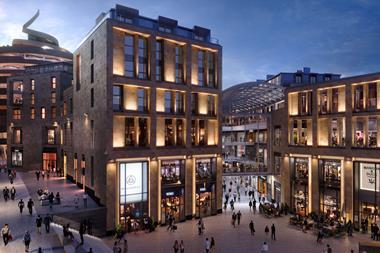Shopping centre marketing part funded by service charges should lead to increased footfall and sales. So why don’t retailers know where the money is going, asks Sara McCorquodale?
Retailers contribute towards the cost of shopping centre marketing, yet seem unable to quantify the benefit they get from it. With many rolling out their own multimillion pound, multimedia campaigns and sponsored events, the impact on sales of a single centre’s promotions can seem insignificant.
So what do retailers get for their money and does it provide good value compared with the marketing budgets they directly control?
For the past three years, the average marketing spend within service charge budgets has been cut, a Jones Lang LaSalle report revealed. While cleaning and security costs have continued to increase, the amount dedicated to promotion has dropped from 50p per sq ft in 2005 to 33p in 2008.
The reasons for this are varied. The general issue of the service charge is one that can cause disagreement among retailers. However, the marketing derived from it is an area many of the bigger brands seemed apathetic about.
When approached, DSGi, New Look and Waterstone’s had no comment to make on the marketing resulting from the service charge.
Sainsbury’s local marketing team said it didn’t get involved in the campaigns devised and executed by shopping centres.
Marks & Spencer thought the issue was one affecting smaller retailers rather than itself – generally an anchor.
While they do not object to paying the mandatory service charge, bigger retailers do not necessarily expect significant results from the marketing it funds.
An HMV spokesman reinforced this, saying: “Ultimately, we see marketing as being down to us – anything else is an extra. It’s difficult to measure where our promotion begins and its [the shopping centre’s] ends.
“If there is a service charge we just accept it is part of the price to pay but we don’t have any great expectations from the shopping centre.”
Smaller retailers also do not have huge expectations from shopping centre marketing – mainly because they do not believe they are a priority. Red5 managing director Jonathan Elvidge, says: “It would be good if we were more involved. I’m confident if we were an anchor we would be more included, I suspect the larger retailers are.
“I haven’t seen a great deal of results from any of this marketing, I guess a lot tenants aren’t closely involved to a great extent,” he added. “For me, this is just part of the cost.”
In 2004, the British Property Federation (BPF) found that despite shopping centre marketing exceeding £80m each year, retailers were dissatisfied with the effects. As a result, the body drafted the Good Practice Guide outlining how a shopping centre should be marketed.
To ensure retailers support future expenditure, it advised shopping centres to provide evidence of a list of things including sales growth, footfall conversion measurement and media coverage.
This message, it seems, is not being heeded, as both Elvidge and HMV stated they have very little interaction with the marketing teams of the centres they are tenants in.
Elvidge says: “I was pleasantly surprised recently to see a shopping centre we’re a tenant in advertising on local TV, showcasing all of the retailers in the scheme. It was nice to see us there on-screen. But I was surprised because nobody left us a message or told us it was happening. That, in itself, would suggest better communication is needed.”
Spread the message
HMV believes while minimum interaction is the traditional approach of shopping centre marketing teams, newer centres are more transparent.
“I can’t recall having any kind of regular dialogue but perhaps that is the future,” the spokesman says. “There have been calls from agencies asking for our thoughts on certain aspects to do with marketing. I think the more contemporary shopping centres are thinking in this way.”
Due to the continuing recession, shopping centres need to show retailers the service charge is money well spent. Evidence of a marketing initiative’s success has to be presented to the retailer. Otherwise centres must be prepared for retailers to ask for caps or reductions on the amount spent.
Jones Lang LaSalle head of shopping centre management Catherine Lambert says: “Retailers are asking for more justification and some owners do provide quite sophisticated measures of the impact of marketing and can show if it has resulted in better conversion rates, better footfall and increased spend.”
Lambert added that retailers are looking for more ways to cut costs. Several are insisting the marketing budget does not go over a certain percentage and asking for changes to cut the service charge in general.
However, Leigh Burnett, asset manager for shopping centre management firm Plus Shops says shopping centres’ marketing budgets are essential and cutting them will have a detrimental effect on the tenants of the facilities.
She says: “You need marketing outside of your immediate market to stop leakage to other centres and to keep the centre’s profile up. But landlords need to look carefully at how to spend the marketing budget from the service charge.
“We look at other ways to bring people into the centre like events,” she adds. “They can be more worthwhile than paying for press advertising.”
The reason for shopping centre marketing is easily identifiable. Instead of advertising a brand, product range or promotion these campaigns sell a destination – a place in which consumers want to shop in not just because of the range of retailers.
However, they need to look at their anchors’ individual campaigns to ensure success.
Deborah Owen-Ellis Clark is part of the British Council of Shopping Centre’s retail marketing group. She says: “The crucial thing is to work with the bigger retailers’ campaigns to make sure there are similarities and a commonality. It stands to reason you are working with a similar customer base and therefore share your marketing message.”
The anchors of a centre will always be heavily promoted as they provide the biggest draw. However, consultation with all tenants should ensure a balance in how the centre is promoted.
The BPF’s Good Practice Guide suggests marketing teams should meet with retailer’s representatives to develop promotions plans. The resulting strategy should be made available to all tenants and their head offices.
The guide also promotes transparency in terms of how marketing costs will be divided between landlords and tenants, and a breakdown of how this budget will be spent. Retailers should be aware of any consultant’s fees or research costs, in addition to events and advertising expenditure.
Although this will keep everyone informed, satisfying the needs of big and small retailers is an ongoing problem.
“It’s difficult to include everybody when you are doing promotion,” says Burnett. “You’ve got to get over the fact there’s a mass and everyone is paying a proportion. They all need to feel like they’re getting value. The anchors pick up a substantial amount of the service charge and they need to be satisfied. Retailers need value across the board.”
Owen-Ellis Clark points out driving footfall for the larger retailers is likely to benefit their smaller counterparts too. However, at a time where staying afloat is key, retailers seem ambivalent to the effects of shopping centre marketing.
Low expectations and poor communication appear to have bred indifference, with most we spoke to choosing not to comment or saying they had little to do with the process.
Change could be in the pipeline with the young leading the old towards a new approach. Contemporary centres like Westfield understand, according to HMV, that “high-profile brand names are worth singing about”, and are leading the way in marketing a destination worth visiting. But an increase in communication, dynamism and transparency is required.
Shopping centres may be good at communicating with shoppers, but they must ensure they also communicate their marketing strategies back to retailers too.
Employing research Bluewater
Kent shopping centre Bluewater houses 330 retailers. Following a 14-month review in conjunction with Finance Forum and stakeholders, it announced an 8.2% decrease in its service charge budget last month. Retailers now pay an £11.96 charge per sq ft.
Bluewater opts for a research-led approach to marketing, with a strong emphasis on developing customer relationship management.
Bluewater general manager Andrew Parkinson says: “The development of databases has been really important as we can take a more targeted approach. It’s about getting people into the centre but also getting the right demographic from the catchment area that is going to spend money in the stores.
The centre asks guests what they liked about it and what was missing, to measure year-on- year change.
“We find out what customers liked and what they didn’t like and we get in sales figures from all of our retailers. This lets us really have a good look and see which ones are performing well and which categories are performing best. It lets us see who we should be doing more for,” Parkinson says.
The owner of the centre covers 50% of marketing costs and retailers’ pay for the remaining 50% through the service charge. This funds both above- and below-the-line marketing.
Parkinson believes having a strong partnership with retailers and being transparent about the effects of marketing are essential.
“You’ve got to be able to demonstrate that you are achieving footfall and increased sales,” he says. “We’ve had a strong partnership with retailers and we meet monthly to discuss marketing strategies. We need to know what was successful before and how we can make it better.
“There is a lot more retailer involvement than there was in the past. We work with the retailers to define what advertising campaigns should look like.”
An event strategy St Nicholas & Bon Accord
The St Nicholas and Bon Accord centres in Aberdeen house more than 70 retailers between them. The marketing team takes an events-led strategy to get the local community into the centres and gain coverage in local press.
Marketing manager Cheryl Baer says: “We hold a number of events that are appropriate to our different retailers and make sure we plan lots of activities for families. When it comes to advertising, we use a mix of media and work closely with an agency to make sure we follow campaign objectives and everyone gets value.”
Both centres are currently using events and promoting itself on Twitter. They have launched a competition called “Twitter the slipper” in conjunction with the city’s pantomime this year in which clues to find Cinderella’s slipper are left on the centres’ Twitter page as part of
a treasure hunt.
Talent competitions and fashion shows have also allowed the marketing team to demonstrate footfall and increased sales, and created press coverage. The marketing team also hold community events as a way to attract local people to the centre.
Retailer involvement in centre marketing campaigns is welcomed and the marketing team keeps tenants informed of upcoming plans to get more shoppers into stores.
“We work very closely with all of retailers’ head offices to let them know what we are doing and find out what else we could be doing,” says Baer. “We also take into consideration their individual campaigns when we are devising ours. We like to make sure we are giving out the right message.”
Transparency is also key in developing a good retailer and centre relationship. Tenants are kept informed about upcoming events and promotions that they can get involved in and the direction of marketing campaigns.
Baer says she always encourages retailer involvement: “It makes sense because then we can showcase any product promotions or in store events they have planned.”


























No comments yet